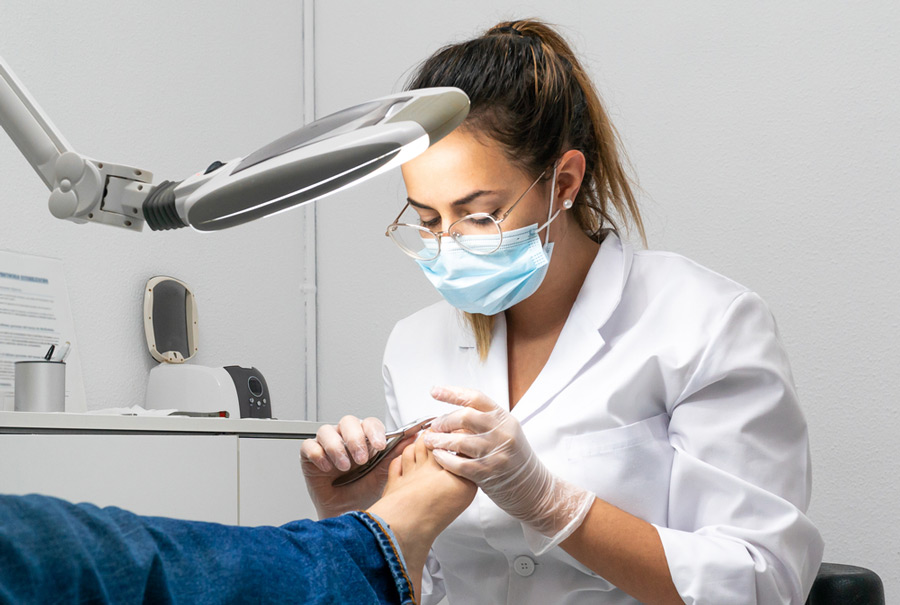Buy or build?
Should you start a podiatry business from scratch or purchase an established practice?
Buy or build from scratch?
The definitive guide for would-be podiatry practice owners.

The compelling case for owning and operating your own podiatry business.
“Never before will so much have been required from so few”
It is anticipated that record government deficits and underlying debt will inevitably lead to cuts to the NHS budget – and that these cuts will directly impact chiropody services and foot care provision within the public sector framework (in the same way that other areas such as NHS ear wax removal/micro suction have been rationed in the audiology/ear care space).
An ageing population, coupled with increasing levels of obesity and Type 2 diabetes, is likely to require more foot-related interventions and treatments. This increase in demand and caseloads within the NHS will compound the budget cuts and further stretch increasingly scarce podiatry provision within the public health framework.
When it comes to the NHS’s podiatry provision, an extrapolation of these trends into the future resulted in our healthcare analyst Dominic Watson coming to a key and very sad conclusion: When it comes to NHS podiatry provision “Never before will so much have been required from so few.”
Against this stark backdrop, it is easy to see why a move out of NHS podiatry into independent practice ownership for HCPC qualified podiatrists is becoming so compelling. Indeed, when it comes to entering the private sector, for many chiropody professionals, the only remaining question is not “should I?” but “HOW SHOULD I?” make the transition to my own private podiatry business?”
There is one other massive advantage to owning your own podiatry business. If operated intelligently and prepared in the right way via exit planning, a private podiatry practice can become a valuable store of wealth; something that when the time is right for you can be sold to help fund your retirement. You can’t sell your NHS job, but you can sell your practice (whilst earning handsomely during your ownership).
Owning your own podiatry business: The options
When it comes to owning your own podiatry practice, there are 2 main options:
However, a word of caution. Whilst there are only 2 main pathways into practice ownership, it is far from a simple, binary choice. This is because podiatry businesses come in all shapes and sizes – and so do their prospective business owners! Because of this, when it comes to determining what is the right approach for you, it is important to:
- Educate yourself on your options by obtaining a full understanding of the different types of podiatry businesses and business models that you can potentially build or buy.
- Take the time to think through and clearly determine your own current needs, goals, assets, attributes and skill sets
Once you have clarity and are fully informed on these key factors, the correct entry point should become much clearer.
The different types of podiatry business models
Whether you are looking to start your podiatry clinic from scratch or to acquire an existing one, it is important to be fully aware of the different models and the pros and cons of each.
There are 2 main operating models to choose from:

Domiciliary model
Advantages
- No premises to fit out, maintain and clean.
- No ongoing costs for rent, rates, light or heat.
- With an ageing population this is a massive, growing market. This is evidenced by the – snappily named – study Prevalence of Foot and Ankle Conditions in a Multiethnic Community Sample of Older Adults which found that:
- 25% of the population over the age of 65 live with a degree of foot pain
- 75% of this older segment of society suffer a nail condition
- 58% have callus or corns that when left untreated impact on their sense of wellbeing and quality of life
- 60% have some degree of toe deformity.
- A wide range of painful or debilitating foot issues such as bunions, cracked skin, ingrown toenails, fungal infections and ulcerations are also present in this older age segment.
- Those operating in this niche area benefit from variety in terms of the location day to day (instead of being stuck in the same four walls of a fixed clinic environment).
Disadvantages
- Serving the very elderly and infirm comes with practical challenges around communication and delivery of care. As a result, domiciliary work within the foot care sector requires significant patience, empathy and understanding from podiatry clinicians. Working exclusively with geriatric patients is not for everyone.
- For those looking to provide the best possible care and the widest range of treatments, domiciliary work can be physically demanding, requiring a significant amount of equipment to be lifted in and out of cars and carried into patients’ homes.
- Care homes offer an attractive level of scale and efficiency, in that it may be possible to see a significant number of patients in a back-to-back clinic on a single visit. However, winning and keeping an agreement with a care home can be difficult. Arrangements are typically via relationship and very informal agreements with the Care Home owners or management.
- Domiciliary foot care providers often have agreements to service multiple care homes owned by the same operator. The loss of any such relationship (for example if the owner sells out and a new operator comes in and terminates access for the incumbent podiatry business) can lead to a dramatic loss in patients and revenue levels for a domiciliary podiatry business.
- In contrast, caring for the elderly who do not reside in care homes (assuming it is undertaken at a commercially viable scale, not at a ‘lifestyle business’ level) requires complex planning and logistics to ensure efficiency of travel between patients’ homes. Even with highly efficient logistics and diary management, travel time between patients means that it will never be possible to see the same number of patients in a day’s clinic as could be done in a brick-and-mortar practice – or at a care home.
- The high level of travel involved in domiciliary work means that congestion and parking challenges are often part and parcel of the day-to-day experience given the increasing levels of traffic and decreasing levels of available parking. This can at times make domiciliary podiatrists run late, putting them under additional stress and pressure.
- A focus on older, home bound patients inevitably means less varied work and arguably less interesting work (none of the running, cycling and sporting issues that you would get when working with younger patients and the great conversations that go with treating active, motivated patients).
- The lack of formal contracts for care homes and the relatively short life expectancy for patients living on their own, means that domiciliary businesses are by their very nature more transient, ethereal entities that typically do not transfer as readily or achieve as high values as bricks and mortar podiatry businesses, when their owners wish to sell and exit.

Bricks and mortar model
There is a surprising variety of options when it comes to “bricks and mortar” podiatry practice models. Again, the options are non-binary, with many operators harnessing a multi-site approach that utilises more than one bricks and mortar clinic ‘model.’ Many clinic owners also choose to offer a limited level of domiciliary service to the elderly within the immediate catchment area of their physical practices.
“Bricks and mortar” podiatry practice models:
Embedded podiatry clinic
Embedded podiatry clinics operate from a room within premises owned (or leased) by another healthcare provider such as a dentist, audiologist, optician or pharmacist.
Embedded clinics typically share a common entrance and waiting area with the host.
Arrangements can vary considerably – for example an optician or GP surgery may have spare capacity of a day or two a week within one of their consulting rooms – and may grant access to a podiatrist to utilise this spare capacity on the days the room is not being used by the core business. Commercial arrangement for embedded clinics can be very loose – along the lines of a verbal/gentleman’s agreement that the room can be used at a certain agreed price per day. They can also be more formally documented via some form of licence arrangement (different from a lease in that it does not grant exclusive use of the area). A commission-based structure may sometimes replace or supplement a room rental fee. For example, a podiatrist may pay a % of their revenue to their host.
Advantages
- Lower set up costs for new start-ups and a cheaper price point if purchasing an existing embedded chiropody business compared to one with full control over the property and trading environment.
- Reduced liabilities and risk.
- Embedded clinics normally come “fully plug and play” with no need to decorate or invest in putting in power, water or other facilities.
- Embedded podiatry clinics tend to have much looser arrangements than the sometimes-onerous leases for high street premises – or the risk and stretch of borrowing to buy a freehold.
- Ability to benefit from the host’s existing patient base and cross sell podiatry services to a captive audience.
Disadvantages
- The downside of the looser contractual terms is reduced security of tenure for the embedded podiatry business (when compared with more formal lease arrangements which often afford up to a decade of guaranteed occupancy, or permanent occupation rights if starting or buying a podiatry business that owns its own freehold.).
- Whilst a certain number of patients may come from passing trade and other marketing initiatives, optimal conversion rates are likely to only be achieved via consistent proactive recommendations by the host to their patient base. Sadly, this does not always happen in practice.
- Due to their inherent reduced security of tenure, embedded clinics are more difficult to sell and tend to attract lower values and more hedged payment terms on sale. However, they can be a great, low-risk way to buy or start a podiatry business that – once the owner has a strong recurring reputation and patient base and good cash flow – can be relocated to more secure dedicated premises.
Home-based podiatry clinic
This business model involves operating clinics from a spare room in the podiatrist’s own home (or an annex).
Advantages
- Low risk, low initial expenditure and minimal liabilities.
- Security of tenure – you are your own landlord and do not have to answer to anyone else.
- No commute – offer incredible time and financial savings over the long-term.
- Low cost – no rent to an additional third party and minimal additional running costs.
- All the above factors mean that home-based podiatry clinics can truly be owned and operated to fit in with the owner’s lifestyle.
Disadvantages
- Low/negligible visibility to potential customers mean that you will have to work harder to drive in new business via proactive marketing and networking activities.
- Lack of separation between home life and work life.
- Depending upon the specific set-up, home based podiatry clinics can look unprofessional, and some patients may find it strange or may be put off by having to go into someone’s home. In many cases, the less professional look and feel of a home-based clinic can make it much more difficult to justify higher-end premium fees for treatments (although you could argue that this is offset by lower overhead costs).
- Typically, small scale affairs – one-man/one-woman bands, with few interactions with other clinical professionals or support staff – can make owners of home-based podiatry practices feel isolated and in a bubble.
- Poor stores of wealth as they are difficult to sell when the owner wishes to retire (but can be a good starting point to build up an initial patient base and then relocate the practice to dedicated premises at a later date as part of a phased business growth strategy).
- Can make you unpopular with your neighbours, with possible pain points arising around parking, deliveries and noise/nuisance issues due to the increased comings and goings.
Dedicated commercial premises
Podiatry businesses operate from a wide range of dedicated commercial premises including:
- Commercial shop premises in primary high streets across the UK’s towns and cities which benefit from high passing footfall levels – either freehold or leasehold.
- Shop units in secondary and tertiary locations – either freehold or leasehold.
- Medical centre-based clinics – normally under a standard commercial lease affording a reasonable degree of security.
Advantages
The pros and cons of owning a commercial freehold versus leasing a business premises for your podiatry business go beyond the scope of this resource. As does the hybrid ‘virtual freehold’ option! If you would like to talk these options through in more detail, please do get in touch (my contact details are at the bottom of the page). However, both options have the following advantages compared to the alternatives of an embedded clinic, domiciliary delivery or home-based podiatry operations:
- Typically look more professional.
- Higher visibility and therefore likely to benefit from organic growth from passing trade.
- A good level of security of tenure (in layman’s terms, the right to occupy the premises without risk of being kicked out (so long as you pay the rent or commercial mortgage and stay within the bounds set out in the lease or commercial mortgage) :
- Freehold offers indefinite guaranteed right to trade from the premises (with the very rare exception of a compulsory purchase order if the wider area is to be redeveloped.)
- Leasehold offers a guaranteed period of occupation and depending upon the type of lease – the majority of leases fall under the Landlord and Tenant Act 1954 which carries an automatic right to renew (with one or two specific exceptions.)
- Practices operating from bricks and mortar premises typically have the capacity to grow quicker and generally reach a larger scale – some practices may operate 5 or more concurrent clinics. (Usually moving premises several times to increase capacity, rather than starting off with huge premises and overheads and few patients!)
- Subject to transferable security of tenure, podiatry businesses occupying Bricks and mortar premises tend to achieve higher resale values (due to their scale)
Disadvantages
- More risk and more expenditure in terms of:
- Potentially higher set up costs if starting from scratch (to turn the commercial unit into a clinic with a separate reception area etc.)
- Higher fixed overheads – monthly rental or mortgage payments
- Potential exit costs
- Less flexibility / longer tie in – taking on a commercial mortgage or lease, together with the added set up costs ties you in for longer when compared to most of the other options.
Specialisms and podiatry business models
When thinking about buying or setting up a podiatry clinic, it is essential to consider the specifics of the existing businesses or your planned business’s operating model.
Who are you most comfortable working with and what areas do you excel in and most enjoy? Be realistic. You also need to think about which treatments are likely to be the most profitable? Furthermore, you may love biomechanics and working with younger, sportier clients – but most podiatry businesses’ bread and butter income comes from routine work delivered to middle-aged and elderly patients with sufficient disposable income to allow them to pay privately.
If the principal of a practice you are considering buying currently undertakes medico-legal work, do they plan to continue with this element post-sale? Is it something they will be willing to teach you in the future? How much profit will be left in the core business if this revenue and profit centre is not included in what you are buying?
Know your market and know your customer
Look at the catchment population of the town or city you are considering. How much competition is there? If you are starting from scratch, is there much unfulfilled capacity? If you are buying an existing practice – is there room for further growth?
In either case – why would they come to you?
Buying a podiatry practice vs starting from scratch
Around 60% of small business new start-ups in the UK fail within 3 years of their inception.
Specific data on the success and failure rates of new start up podiatry businesses is hard to come by. Bill Clinton famously and very wisely advocated “following the trend lines rather than the headlines.” Whilst we can’t give you the overall market statistics for podiatry, we can certainly help you with the trendlines. Having worked in the healthcare sector for over 2 decades (delivering business coaching and business brokerage services) our team has had a unique insight into the fates of hundreds of people who have both bought existing businesses and started their own podiatry clinics from scratch.
First the good news is that – compared to the wider market – failure rates for both podiatry start-ups and purchased podiatry businesses are extremely low. There are number of reasons for this:
- Compared with so many other businesses – as a hands-on, healthcare service, podiatry is safe from incursions from online offerings that have disrupted and decimated so many other small local businesses – and looking ahead should be safe from the threat that AI poses to so many other industries!
- Compared with other healthcare sectors (like dentistry or optometry) the start-up costs for equipment, fixtures and fittings are relatively low.
- As detailed already – with an ageing and increasingly unhealthy population and massively stretched NHS budgets – the private podiatry sector is a growing market with an abundance of patients requiring help.
But for the sharp eyed amongst you, you will have noted that this is only half the story.
The failure rate is low, but what about the success rate? To explore this in a meaningful way, we must first define what we mean by success.
Just because a podiatry business has not failed and gone out of business, does not automatically mean that it has become a great success either. A good number of start-up practices end up remaining tiny – frequently earning their owners less than they could have earnt by working for someone else.
When operating a podiatry business what constitutes success depends entirely upon the goals of the owner. This means that when you are thinking about buying or starting a podiatry business, it is critical to clearly define your goals.
There are many reasons podiatrists choose to get into business.
- Financial drivers
- Many podiatrists seek to get into business to earn more than they can in an employed role
- Some are highly money motivated and are looking to become highly commercial in order to maximise their potential earnings
However, for most it is not only about the money, but there also tend to be a host of other personal, emotional and self-actualising motives such as:
- Being your own boss and not having anyone else to answer to
- Running clinics the way you want and serving the local community with a higher standard of personal service and care
- Putting your own price on your time and skillset
- Spending as much time as you like with patients per treatment
- Using the products you want to
- Delivering the services you choose and enjoy delivering
- Operating clinics flexibly or on a part-time basis to fit around family and lifestyle requirements
- Working alone or leading at team
Measuring success is not always a simple thing. A podiatrist who is not the main breadwinner, may choose to start their own clinic and run it to fit around children or ageing parents. As a result, they may end up earning less than they did before – but may still consider their start up to be a great success if it meets the criteria, they set out to achieve.
But what about you and your specific goals and requirements? What is the best way to get into ownership?
Let’s go back to those trendlines.
As a basic rule of thumb, in most cases the following holds true:
- If your primary motivation is financial and you have existing overheads to support such as a family home, car payments and dependents, I would recommend that if an existing practice is available at a sensible and affordable price then this is likely to be the best option for you to fast-track and achieve your requirements. Our resource on how podiatry businesses are valued will help you better understand what fair value looks like.
- If your primary motivation lies elsewhere, in non-financial self-actualising drivers, such as flexibility, self-expression etc, you don’t have significant personal bills to pay AND there is no major time pressure on getting up to any level of scale – then starting a practice from scratch (on a small-scale basis) from your home, on a domiciliary or as some form of embedded clinic arrangement (i.e. without taking on significant monthly business liabilities) may be the best route for you.
Let’s now go a little deeper and look at the factors behind this rule of thumb recommendation.

Buying an existing podiatry business
Advantages
- Lower risk – One of the primary advantages of buying an existing podiatry business is the pre-existing “goodwill” of the loyal client base you will acquire. (In stark contrast, building a patient base from the ground up, which requires substantial time, effort and marketing investment and the outcomes are far less certain). This means that as long as the transition between the outgoing and incoming owner is undertaken with sensitivity and the right messaging – it should ensure immediate revenue and continuity of care. When transitioned competently, this steady income stream should allow the new owners to focus on enhancing services rather than struggling to attract initial clients. In other words, most people who buy a podiatry business get off to a flying start and are busy from day one of their ownership journey!
- A “turnkey” operation with a proven business model – Existing podiatry businesses come with established, proven business model. They have navigated the challenges of start-up phases and have fine-tuned their operations. This provides a new owner with a blueprint for success, including established procedures, pricing strategies and effective marketing tactics. Running with an existing model minimises the trial-and-error learning on the job and the significant risk of failure it carries.
- Easier Financing – lenders are generally more willing to finance the purchase of an established business than a start-up. The historical financial performance of an existing business provides investors with confidence in the business’s ability to generate revenue and repay loans. For further information about specialist healthcare lenders willing to fund the purchase of podiatry practices please get in touch.
- A more predictable, positive outcome due to Immediate Cash Flow and profitability from day one (as long as you buy wisely, and the ownership transition is done well). The revenue generated from the existing client base should cover operational costs, your personal living costs as well as servicing any acquisition loans, providing financial stability and a much more predictable set of outcomes from day one.
- Loyal Staff and Established Relationships – Depending upon the scale, an existing podiatry practice may well come with staff who are familiar with the operations, customer journey and administrative duties who will continue to support you and impart their “know how” once the old owner’s hand over period is complete and they have fully exited the business. To a certain extent, some of the practice’s goodwill may reside with staff other than the owner – and their retention will help ensure patient retention. Additionally, an existing practice will have established relationships with the main podiatry suppliers such as Canonbury and other key suppliers and patient referrers. These relationships – particularly other healthcare professionals who will refer new patients to your practice- are highly valuable assets that can take years to develop independently.
Disadvantages
- Buying an existing proven business is likely to come at a higher cost than starting up from scratch
- The podiatry practice sales market is a small specialist market and there may be no existing owners looking to sell in your area within a reasonable timeframe (please get in touch about our “practice finder” service).
- Inherited staff may come with bad habits
- The trading name may pertain to the old owner and may carry a level of the practice’s goodwill with it. It will need to be retained and if it is to be transitioned, this needs to be done very carefully.
- Equipment is likely to be older than if you start up from scratch (but of course can be replaced over time).
- The physical premises that the business occupies may not be in the exact location or optimal size or layout that you would have ideally chosen.

Setting up a new podiatry business
Advantages
- Lower initial set up costs to buy the equipment and get up and running.
- You can choose your ideal location and premises.
- You can develop your own culture, corporate brand and systems to suit your vision, rather than inheriting someone else’s and having to adapt it over time.
- No inherited staff – you get to hand pick your own as you expand (or use a 3rd party virtual receptionist service to book in patients as a highly cost-effective alternative without a need to directly employ staff).
Disadvantages
- Outcomes in terms of revenues and profitability much less predictable than when buying an existing practice. A business plan is an educated guess!
- High likelihood of low patient numbers during the opening months and years.
- Poor initial cashflow – you are likely to lose money during the early stages – especially when you factor in the “opportunity cost” of the salary that you could be earning elsewhere.
- The high marketing spend during the early months and years is likely to offset the perceived advantage of lower up-front costs for starting from scratch.
- Without proven systems, you will have to create your own – and there is likely to be a time and financial cost for learning on the job when mistakes are inevitably made along the way.
Conclusion
While starting a new podiatry business may seem appealing for those wanting to create something from scratch, the advantages of purchasing an existing practice are substantial for anyone who needs to achieve a reasonable financial return. From an established client base and proven business model to more immediate and regular cash flow and easier financing, the benefits of acquiring an existing podiatry business will more often than not outweigh the challenges of starting anew. For podiatrists aspiring to become business owners, purchasing an existing chiropody practice is a strategic and generally more successful path to achieving professional and financial goals.
Whatever your preferred route to practice ownership, the friendly team at Podiatry Business Central are here to help.
For more details or to register your interest in buying an independent podiatry business, please get in touch via 0161 929 8389

For more details or to register your interest in buying an independent podiatry business, please get in touch via 0161 929 8389
The sooner you take action, the sooner we will be able to help you maximise business value and attain your personal goals.


